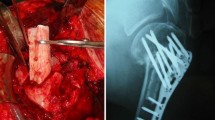Abstract
We reviewed 12 male patients with scaphoid nonunions treated by open reduction, bone grafting, and internal fixation with biodegradable implants made of self-reinforced poly-l-lactic acid. Mean patient age was 22.5 (20–25) years. Ten patients had type D2 scaphoid nonunions with a fracture line in the middle one third, one patient had type D2 nonunion with a fracture line in the proximal one third, and one patient had type D1 distal one-third fibrous union. The mean wrist score (modified Mayo wrist score) was 20.8 (10–40) preoperatively and improved after 22–80 months (55–90). All nonunions healed, and the mean solid union time was 4.5 (3.5–7) months. We obtained excellent results in five patients, good results in four, fair results in two, and a poor result in one. The results of this study offer a valid alternative in the fixation of scaphoid nonunions. The major advantage of biodegradable materials is to eliminate the requirement for the removal of the fixation material.
Résumé
Nous avons examiné douze malades de sexe masculin avec une non-consolidation du scaphoïde traitée par réduction ouverte, greffe osseuse et fixation interne avec des implants biodégradables faits d’acide poly-l-lactique auto-renforcé (SR-PLLA). L’âge moyen des malades était de 22.5 ans (20–25). Dix malades avaient une non-consolidation de type D2 avec le trait de fracture dans le tiers central, un malade avait le type D2 avec un trait de fracture dans le tiers proximal et un malade avait le type distal D1 avec union fibreuse. Le score moyen du poignet (Mayo wrist score modifié) était 20.8 (10–40) en préopératoire et amélioré après 22 mois à 80 (55–90). Toutes les nonunions ont consolidées dans un temps moyen de 4.5 mois (3.5–7). Nous avons obtenu d’excellents résultats chez cinq malades, de bons résultats chez quatre, des résultats médiocres chez deux et un résultat mauvais pour une. Les résultats de cette étude offrent une alternative valide pour la fixation des non-consolidations du scaphoïde. L’avantage majeur des matières biodégradables est d’éliminer l’exigence d’ablation du matériel d’ostéosynthèse.
Similar content being viewed by others
References
Blasier RD, Bucholz R, Cole W, Johnson LL, Makela EA (1997) Bioresorbable implants: applications in orthopaedic surgery. Instr Course Lect 46:531–546
Böstman OM (1991) Osteolytic changes accompanying degradation of absorbable fracture fixation implants. J Bone Joint Surg Br 73:679–682
Böstman OM, Pihlajamaki H (1996) Routine implant removal after fracture surgery: a potentially reducible consumer of hospital resources in trauma units. J Trauma 41:846–849
Böstman OM, Makela EA, Tormala P, Rokkanen P (1989) Transphyseal fracture fixation using biodegradable pins. J Bone Joint Surg Br 71:706–707
Böstman OM, Hirvensalo E, Makinen J, Rokkanen P (1990) Foreign-body reactions to fracture fixation implants of biodegradable synthetic polymers. J Bone Joint Surg Br 72:592–596
Bucholz RW, Henry S, Henley MB (1994) Fixation with bioabsorbable screws for the treatment of fractures of the ankle. J Bone Joint Surg Am 76:319–324
Herbert TJ, Fisher WE (1984) Management of the fractured scaphoid using a new bone screw. J Bone Joint Surg Br 66:114–123
Hopa PG, Williamson DM, Coates CJ, Cole WG (1991) Biodegradable pin fixation of elbow fractures in children. J Bone Joint Surg Br 73:965–968
Juutilainen T, Hirvensalo E, Partio EK, Patiala H, Tormala P, Rokkanen P (2002) Complications in the first 1,043 operations where self-reinforced poly-l-lactide implants were used solely for tissue fixation in orthopaedics and traumatology. Int Orthop 26:122–125
Merrell GA, Wolfe SW, Slade JF III (2002) Treatment of scaphoid nonunions: quantitative meta-analysis of the literature. J Hand Surg Am 27:685–691
Partio EK, Hirvensalo E, Partio E, Pelttari S, Jukkala-Partio K, Böstman OM et al (1992) Talocrural arthrodesis with absorbable screws, 12 cases followed for 1 year. Acta Orthop Scand 63:170–172
Partio EK, Merikanto J, Heikkila JT, Ylinen P, Makela EA, Vainio J et al (1992) Totally absorbable screws in fixation of subtalar extra articular arthrodesis in children with spastic neuromuscular disease. Preliminary report of a randomized prospective study of fourteen arthrodeses fixed with absorbable or metallic screws. J Pediatr Orthop 12:646–650
Pelto-Vasenius K, Hirvensalo E, Böstman OM, Rokkanen P (1995) Fixation of scaphoid delayed union and nonunion with absorbable polyglycolide pin or Herbert screw. Consolidation and functional results. Arch Orthop Trauma Surg 114:347–351
Rajagopalan BM, Squire DS, Samuels LO (1999) Results of Herbert-screw fixation with bone-grafting for the treatment of nonunion of the scaphoid. J Bone Joint Surg Am 81:48–52
Santavirta S, Konttinen YT, Saito T, Gronblad M, Partio E, Kemppinen P et al (1990) Immune response to polyglycolic acid implants. J Bone Joint Surg Br 72:597–600
Smith BS, Cooney WP (1996) Revision of failed bone grafting for nonunion of the scaphoid. Treatment options and results. Clin Orthop 327:98–109
Author information
Authors and Affiliations
Corresponding author
Rights and permissions
About this article
Cite this article
Akmaz, I., Kiral, A., Pehlivan, O. et al. Biodegradable implants in the treatment of scaphoid nonunions. International Orthopaedics (SICOT) 28, 261–266 (2004). https://doi.org/10.1007/s00264-004-0580-z
Received:
Accepted:
Published:
Issue Date:
DOI: https://doi.org/10.1007/s00264-004-0580-z




